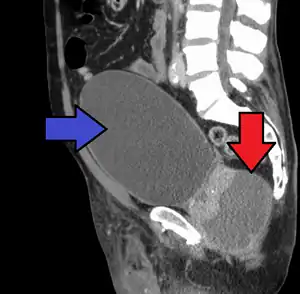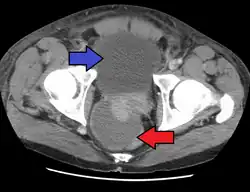Prostate abscess
| Prostate abscess | |
|---|---|
 | |
| CT scan showing an abscess of the prostate (red arrow) resulting in urinary retention (blue arrow) | |
| Specialty | Urology |
| Complications | Sepsis[1] |
| Causes | Acute prostatitis, chronic bacterial prostatitis[1] |
| Risk factors | Diabetes, foley catheter, prostate biopsy, kidney failure, cirrhosis, poor immune function[1] |
| Differential diagnosis | Acute prostatitis, urethritis,[1] |
| Treatment | Incision and drainage, antibiotics, benign prostatic hyperplasia[2][1] |
| Prognosis | Risk of death 1% to 16%[1] |
| Frequency | Rare (developed world), relatively common (developing world)[1] |
A prostate abscess is a collection of pus within the prostate gland.[1] Symptoms may include pelvic pain, fever, blood in the urine, and pain with urination.[1] Low back pain may also be present.[1] Complications may include urinary retention and sepsis.[1]
They generally occurs as a complication of acute prostatitis and less commonly chronic bacterial prostatitis.[1] Risk factors include foley catheter, prostate biopsy, diabetes, kidney failure, cirrhosis, and poor immune function.[1] While various types of bacteria may be involved, E. coli is most common.[1] The diagnosis should be suspected in someone who has acute prostatitis that is not improving and can be confirmed by medical imaging.[1]
Treatment of a prostate abscess often involves incision and drainage and antibiotics.[2][1] The risk of death is between 1% and 16%.[1] Well relatively uncommon in the developed world due to the appropriate treatment of acute prostatitis, prostate abscesses are more common in the developed world.[1] They make up about 0.5% of urologic disease.[1] Older people are more commonly affected.[1]
Signs and symptoms
Symptoms often include pelvic pain, fever, and pain with urination.[1] Complications may include sepsis and urinary retention.[1]
Cause
Prostate abscess generally occurs as a complication of acute prostatitis.[1] Risk factors include foley catheter, prostate biopsy, diabetes, kidney failure, cirrhosis, and poor immune function.[1] While various types of bacteria may be involved, E. coli is most common.[1]
Diagnosis

The diagnosis should be suspected in someone who has acute prostatitis that is not improving and can be confirmed by medical imaging.[1] The preferred method of imaging is generally ultrasound of the prostate via the rectum.[1] CT scan of the abdomen and pelvis may be less painful.[1] MRI may also be useful in certain cases.[1]
Differential diagnosis
Other conditions that can present similarly include urethritis, urinary tract infections, acute prostatitis, chronic bacterial prostatitis, benign prostatic hyperplasia, and a perineal abscess.[1]
Treatment
Treatment generally involves surgical incision and drainage.[2] This may be done via the urethra, rectum, abdomen, or skin of the groin.[2] Antibiotics without surgery may be initially tried for abscesses smaller than 1 cm in diameter.[1]
References
- 1 2 3 4 5 6 7 8 9 10 11 12 13 14 15 16 17 18 19 20 21 22 23 24 25 26 27 28 29 30 31 Reddivari, Anil Kumar Reddy; Mehta, Parth (2020). "Prostate Abscess". StatPearls. StatPearls Publishing. PMID 31869127. Archived from the original on 2021-08-29. Retrieved 2020-11-08.
- 1 2 3 4 Khan, FU; Ihsan, AU; Khan, HU; Jana, R; Wazir, J; Khongorzul, P; Waqar, M; Zhou, X (October 2017). "Comprehensive overview of prostatitis". Biomedicine & pharmacotherapy = Biomedecine & pharmacotherapie. 94: 1064–1076. doi:10.1016/j.biopha.2017.08.016. PMID 28813783.